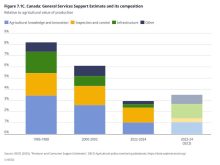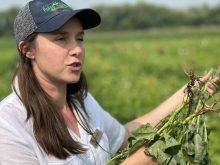Glacier FarmMedia – Keep calm, stay flexible and farm on.
These were the main messages from a panel on greenhouse gas emissions at the recent CrossRoads conference.
Canada, and every member of the G7 and 120 other nations, has committed to achieving net zero emissions by 2050, the manager of government and policy relations for the Grain Growers of Canada told attendees.
Read Also

New ranking elevates Assiniboine College to national research elite
Brandon’s Assiniboine College is 47th in a national ranking measuring research dollars and output at publicly funded institutions in Canada.
And there’s simply no going back, said Branden Leslie.
“What this means is that every government going forward has handcuffed themselves to at least attempting to achieve net zero emissions,” he said. “This legislation is here to stay. It would be politically unpalatable for any future government to repeal this legislation.”
Why it matters: An initiative by the Grain Growers of Canada takes practical and proactive approach to tackling climate change.
That will require changes in farming practices, but don’t be alarmed because there’s nothing new in that, said Grain Growers chair Andre Harpe, who farms near Valhalla Centre, Alta.
“I’m a third-generation farmer. How my dad farmed is not how I farm. Why would we not think that our farms are going to change? It’s going to be a totally different way of farming.”
Reducing greenhouse gas emissions in agriculture became a flashpoint in 2020 when Ottawa set a target of reducing nitrous oxide emissions from fertilizer by 30 per cent by 2030. That prompted accusations — emphatically denied by the federal Liberal government — that the ultimate plan was to force farmers to reduce use of nitrogen fertilizer.
While his organization would oppose any government move toward mandatory fertilizer cuts, said Harpe, it also recognizes that farmers must be part of the effort to reduce emissions.
That’s why it launched an initiative called ‘Road to 2050’ that the organization calls “a practical and proactive approach to tackling climate change.”
“The road map itself is aimed at government,” said Leslie. “It’s aimed at trying to tell the government what policies or programs work and will keep the family farm in this country viable.”
“But in order to communicate with this government, we need to speak their language,” added Harpe.
The nature of the conversation with government has already changed considerably, said Cassandra Cotton, vice-president of policy and programs with Fertilizer Canada.
Two years ago, Ottawa announced its target without talking to those in the ag sector, she said. It was different when Agriculture and Agri-Food Canada recently released its Sustainable Agriculture Strategy, which is now in the public consultation phase, she said.
“It was interesting for us to see that the tone of the strategy was a lot more positive than what the government released in 2020 with the 30 per cent reduction initiative,” said Cotton.
It includes a recognition that farm economics must be part of any strategy, and that farmers here “have been really efficient with their fertilizer use over the past couple of decades, especially compared to their competitors,” she said.
Cotton pointed to recently released data from the UN’s Food and Agriculture Organization that ranks countries on their nitrogen use efficiency. Canada got a rating of 64 per cent, she said.
“Canada already exceeds the world average, which is 55 per cent. Can we be more efficient? Yes, we should, but it has to be science based (and) make sense.”
And the grain sector has a long-established program to build upon when it comes to fertilizer use, she added.
“We’re not starting from ground zero. We’ve had 15 years of effort into the 4R nutrient stewardship program.”

Change is constant
There are also newer emission-reducing technologies that “we need to start looking at,” added Harpe.
One is sprayers with pulse width modulation technology, where each nozzle controls the amount of herbicide.
“We have to look at maybe even reducing herbicides to add to our net zero,” he said.
Another is sectional controls on drills.
“You can look at an even eight to 10 per cent savings on fertilizer,” he said. “It does add up to quite a bit and that would add up to saving on fertilizer without reducing the amount that we put on. It just gets back to right place, right time.”
Technological advances such as green-on-green spraying (identifying and only spraying weeds in a growing crop) show how fast things are changing, said Harpe.
“It’s going to be hard to keep up — it is hard to keep up — but there are things we can do,” he said. “For some of the things this government would like us to do, I think we’re doing it.
“But also, we just have to rely on and look forward to the innovation that is coming up and go from there.”
The grain sector has a good story to tell, added Leslie.
“We have produced historic amounts of grain in this country, vastly outpacing the amount of emissions due to practices that you in this room have undertaken, such as no-till,” he said.
“We have reduced our amount of emissions while simultaneously increasing our yields and increasing our amount that we are able to export and sell to people around the world.”
Data and dollars
Fertilizer Canada has been using surveys to collect more data on fertilizer use and yields, part of an effort to understand the status of sustainable nutrient management now and the barriers to adopting improved 4R nutrient stewardship.
“Certainly, on a lot of the practices that reduce emissions significantly, the return on investment is not as large or is not released immediately because it requires capital cost investment,” said Cotton.
Government can play a helpful role here, she said.
“Sustainable incentives are needed for growers — not subsidies to reduce emissions, but incentives to de-risk practical changes over time,” she said.
And there’s money to be had, said Leslie.
“They (the federal government) have announced nearly $1 billion over the next five years and we need a way to get that into your pocket so we can adopt some of the practices that will result in emissions being reduced.”
This is not about telling farmers what to do, Leslie said.
“We need to find the tools and the financial incentive that will make sense for you to adopt them,” he said. “We have $1 billion going out the door from the federal government. We want it to be spent in a way that will induce you to make actual, practical changes as you see fit.”
Farmers are already employing good practices, such as no-till and variable rate, and they’ve adopted new and better practices time and time again, said Harpe.
So it’s important for government to know that farmers aren’t resistant to change or unwilling to reduce emissions, he added.
“The biggest conversation we will need to tell is that we can do this. But what we need to do needs to make sense for farmers.”
– This article was originally published at the Alberta Farmer Express.
















